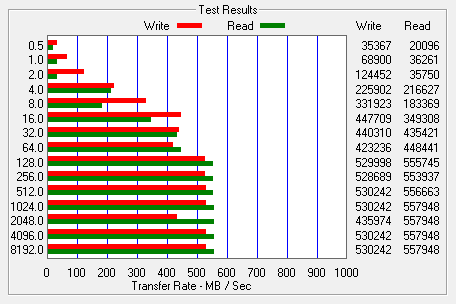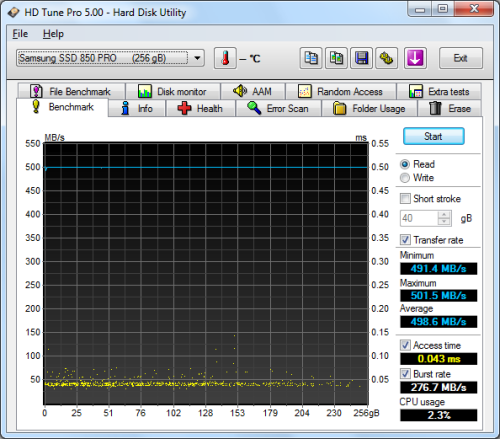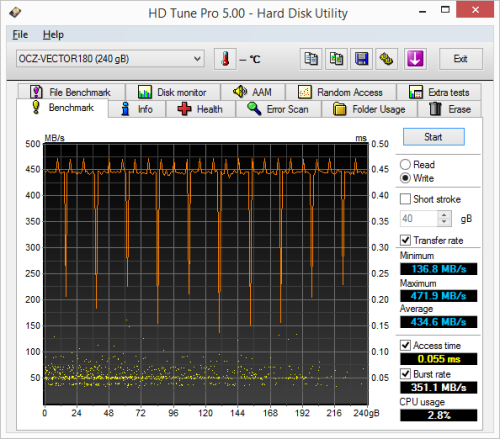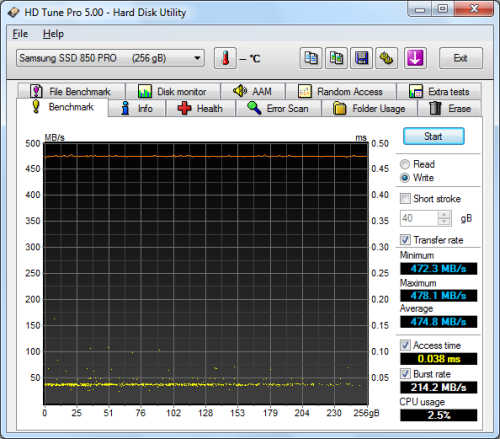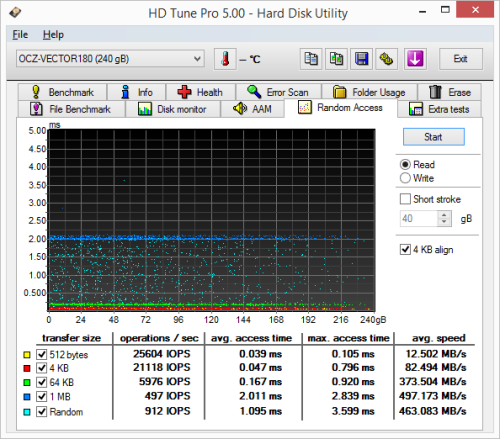

Model: OCZ Vector 180 240GB Solid State Drive
Manufacturer: OCZ Storage Solutions
Provided By: OCZ Storage Solutions
OCZ Storage Solutions is no stranger to the computer industry. Founded by enthusiasts, for enthusiasts, the company entered the memory market in 2002. Determined to manufacture the very best memory for overclockers, OCZ quickly established itself as a leader in the industry by breaking speed barriers and maintaining a reputation of quality. Today, OCZ is fully committed to the solid-state storage market. As a wholly owned subsidiary of Toshiba, the company offers a variety of high-performance SSD solutions for the enterprise and consumer markets.
The latest addition to OCZ's line of consumer-oriented solid state drives is the Vector 180. Continuing the Vector’s legacy, the Vector 180 is optimized for hardcore gaming and data-intensive applications thanks to its powerful OCZ Barefoot 3 controller. This cutting-edge controller is powered by both an ARM Cortex processor and OCZ's own Aragon co-processor and features an advanced, multi-level ECC engine, low write amplification, efficient garbage collection and adaptive flash management algorithms. The Vector 180 also adds support for OCZ's Power Failure Management Plus (PFM+) technology and is equipped with up to 960GB of Toshiba's latest Advanced 19nm (A19) MLC NAND flash. Along with 50GB of host writes per day, the drive is capable of 550MB/s read and 530MB/s write speeds and a maximum of 95,000 4KB random write IOPS.
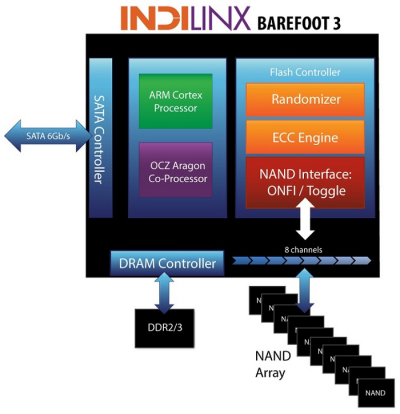
For this review, OCZ sent us the 240GB version of the Vector 150. This SSD comes equipped with 512MB of on-board cache and is capable of delivering up to 550MB/s sequential read and 530MB/s sequential write speeds as well as up to 95,000 random read and 90,000 random write IOPS.
| OCZ Vector 180 240GB Solid State Drive | |||||||||||||||||||||||||||||||||||||||||||||||
General Specifications
Performance
Reliability
Power Consumption
Environmental
Dimensions and Weight
Other Features
|
Needless to say, this is only a taste of what the Vector 180 has to offer. To give you an idea of what to expect, we'll take a closer look at OCZ's new SSD and then see how well it performs. Does the Vector 180 have what it takes? Can it deliver the performance we've come to expect from OCZ's Vector series? Keep reading as we find out.
The Vector 180 comes in a small, black and blue box. While there aren't a lot of details on the front, the back of the box advertises many of the drive's key features including its SATA 6Gbps interface, 2.5" ultra-slim form factor, MLC flash memory, TRIM support and AES 256-bit encryption. Inside the box you'll find the SSD, a 3.5" adapter bracket, mounting screws, installation guide, download instructions and serial number for Acronis True Image and a small sheet of paper with information on how to reach OCZ's tech support.
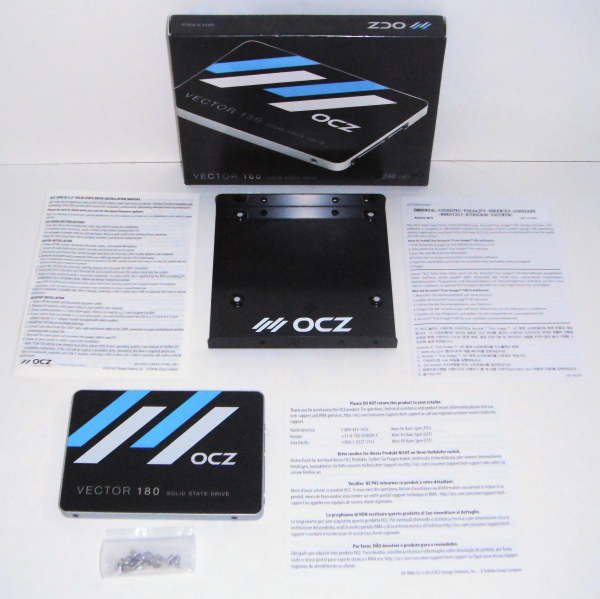
Physical Features:
The construction of the Vector 180 is very similar to that of OCZ's Vector 150 and ARC 100 SSDs. The outer casing is made entirely out of aluminum and is covered by a great looking silver finish. The top of the drive also has a large, black, blue and white sticker showing that it is part of OCZ's Vector 180 series.


Like the Vector 150 and AMD Radeon R7, the Vector 180 uses the Indilinx Barefoot 3 M00 (IDX500M00-BC) controller chip. Designed entirely in-house, the Barefoot 3 M00 is powered by an ARM Cortex processor as well as OCZ's own Aragon co-processor.


For the 240GB Vector 180, OCZ opted to use Toshiba's A19nm TH58TEG7DDKBA4C MLC NAND flash modules. Looking at the pictures above, you can see that there are eight of these 16GB NAND flash packages on either side of the PCB. The drive also has two 256MB Micron 4ZK77 D9PSH DDR3 SDRAM memory chips that are used for caching and garbage collection. The bright orange capacitor on the bottom of the PCB is part of OCZ's Power Failure Management Plus (PFM+) feature which helps prevent "brick drive syndrome" that can occur during sudden power losses.
The test system used in this review was an HP 8200 Elite. The computer came equipped with an Intel Core i5-2400 CPU, 4GB of DDR3 1333MHz memory, Seagate Barracuda 7200.12 ST3250312AS 250GB SATA 6 Gb/s hard drive, NVIDIA Quadro FX580 512MB PCIe graphics card and an Intel 82579-LM gigabit network card. For the operating system, I installed a fresh copy of Windows 7 Enterprise.
To test the performance of the OCZ Vector 180, I ran a series of benchmarks using CrystalDiskMark 3.0.1, HD Tach RW 3.0.4.0, ATTO Disk Benchmark 2.46, AS SSD, HD Tune Pro 5.00, Anvil's Storage Utilities and Iometer. For comparison, I've also included test results from the Crucial BX100, Samsung 850 EVO M.2, Samsung 850 EVO mSATA, AMD Radeon R7, Silicon Power Slim S80, Samsung SSD 850 EVO, OCZ ARC 100, SanDisk Ultra II, Crucial MX100, SanDisk Extreme Pro, Samsung SSD 850 PRO, Plextor PX-256M6S, Toshiba Q Series Pro, Plextor PX-256M6M, Samsung SSD 840 EVO mSATA, OCZ Vector 150, OCZ Vertex 450, Silicon Power Slim S55, Samsung SSD 840 EVO, Seagate 600 SSD, SanDisk Extreme II, OCZ Vector, Plextor PX-256M5Pro Xtreme, and Samsung SSD 840 Pro.
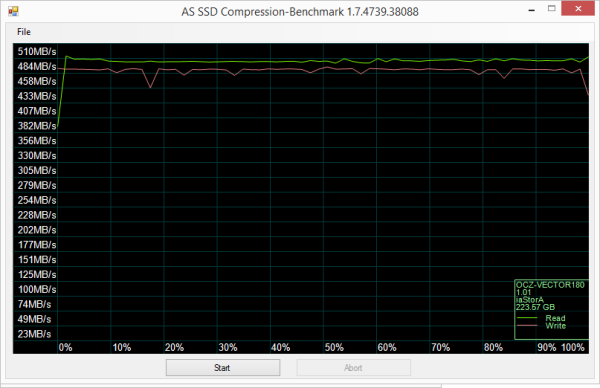
Like OCZ's Vector 150 SSD, the OCZ Vector 180 SSD is based on the Indilinx Barefoot 3 M00 controller platform. Looking at the screenshot above, you can see that, unlike SandForce controllers, it performs equally well with both incompressible (0%) and compressible (100%) data.
CrystalDiskMark 3.0.3:
First, I ran a few quick tests using CrystalDiskMark. This benchmark tool measures the performance of a storage device by testing its sequential read and write speeds as well as its random read and write speeds using blocks 512K and 4K in size.
According to OCZ, the 240GB Vector 180 is capable of reading at 550 MB/s and writing at 530 MB/s when connected to a SATA 6 Gb/s port. While the drive performed well, it came up a bit short of these numbers in CrystalDiskMark's sequential read and write speed tests.
The Vector 180 performed equally well when using highly compressible 0x00 (0 Fill) data. This time around, the drive was able to read at 477.5 MB/s and write at 485.1 MB/s.
HD Tach RW 3.0.4.0:
Next, I used HD Tach to test the Vector 180's read, write and burst speeds as well as its seek times and CPU usage.

OCZ Vector 180 240GB
Looking at the screenshot above, you can see that the Vector 180 had average read and write speeds of 302.8 MB/s and 304.3 MB/s respectively, as well as a burst speed of 435.1 MB/s.
ATTO Disk Benchmark 2.46:
I also used ATTO Disk Benchmark to test the Vector 180's sequential read and write speeds. The tests are run using blocks ranging in size from 0.5KB to 8192KB and the total length set to 256MB.
When tested with ATTO, the Vector 180's read speeds topped out at about 557 MB/s and its write speeds at 530 MB/s.
AS SSD:
AS SSD is a relatively new benchmark designed specifically for solid state drives. The application contains five synthetic tests used to determine the sequential and random read and write performance of a drive.
AS SSD also includes a copy benchmark. This test copies an ISO (two large files), program (many small files) and game (small and large files), returning the speed and duration of each.
HD Tune Pro 5.00:
Next, I ran a series of tests using HD Tune Pro. This hard disk utility measures a drive's performance by testing its sequential read and write speeds as well as its access time, burst rate and CPU usage. For this review, I'm also going to use it to benchmark the Vector 180's random read and write speeds, random access times and the number of operations per second.
The Vector 180 performed relatively well when benchmarked with HD Tune. The drive had average read and write speeds of 474.0 MB/s and 434.6 MB/s, respectively, and a burst rate of 361.4 MB/s when reading.
The Vector 180 didn't disappoint when doing random reads and writes. When writing 4KB blocks, the drive reached 19,510 IOPS and had an average speed of 76.214 MB/s. The Vector 180 was slightly faster when reading, reaching 21,118 IOPS with an average speed of 82.494 MB/s.
Anvil's Storage Utilities:
Anvil's Storage Utilities is another new benchmark designed with SSDs in mind. The standard storage benchmark measures a drive's performance by testing its transfer speeds, access times and IOPS.

Iometer:
Lastly, I ran a series of tests using Iometer. This tool can be configured to benchmark a number of things. In this case, I used it to measure the Vector 180's read and write speeds and the number of operations per second. The tests were run using random bytes and a queue depth of 3.

The Vector 180's performance was very similar to what we saw in our other tests. The drive was able to read at 530.35 MB/s and write at 483.70 MB/s.
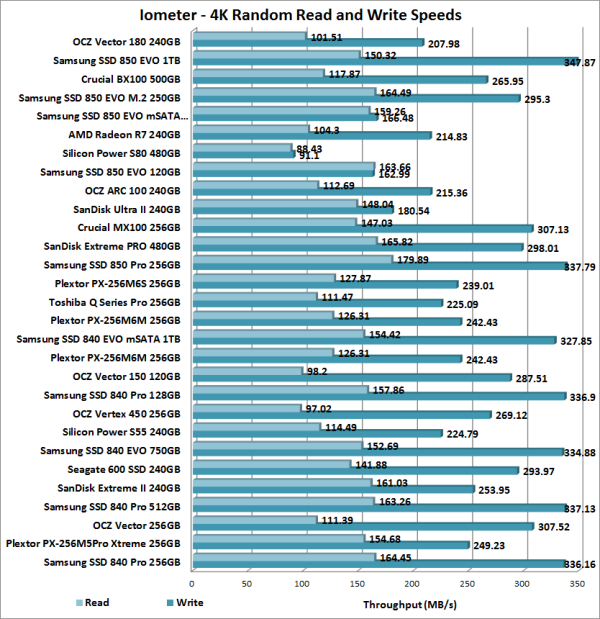
The Vector 180 wasn't one of the faster drives we've tested when it came to random reads and writes. In our tests, the drive was able to read at 101.51 MB/s and write at 207.98 MB/s.
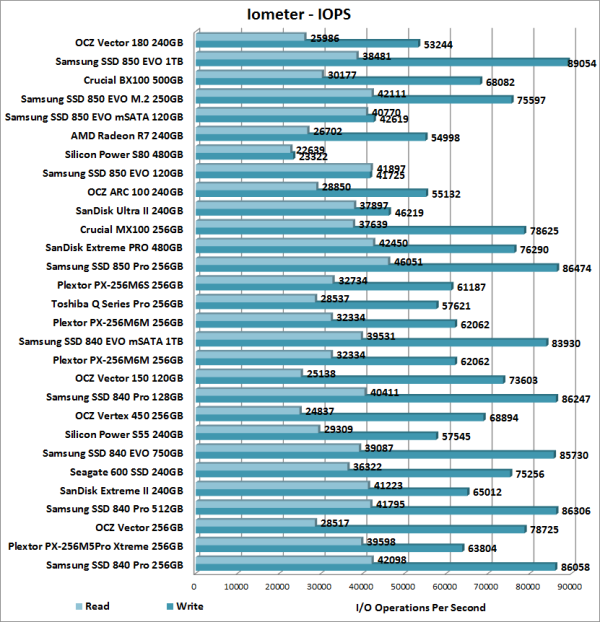
According to OCZ, the 240GB Vector 180 is capable of 95,000 IOPS when reading and 90,000 IOPS when writing 4K blocks. In our tests, the drive reached 25,986 random read IOPS and 53,244 random write IOPS. The only way I came close to OCZ's numbers was to increase the queue depth. With the queue depth set to 32, the Vector 180 reached 88,389 random read IOPS and 81,307 random write IOPS.
Vantage PCMark 8 - Storage Test:
PCMark 8 is a complete benchmark for Windows. It includes five benchmark tests, each designed around a specific scenario. The storage benchmark measures drive performance using real-world traces recorded from Adobe Creative Suite, Microsoft Office and a selection of popular games.
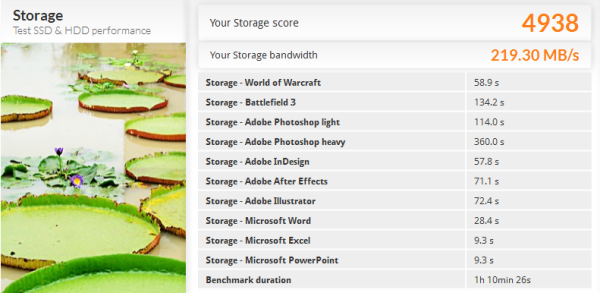
PCMark 8 also includes a consistency test which measures the performance consistency and degradation tendency of a storage system. The test reports the performance level at the start, the degraded steady-state and the recovered state as well as the number of iterations required to reach the degraded state and the recovered state. For this test, we are focusing on the Adobe Photoshop (Heavy) trace and will look at both the bandwidth and latency of the drive


The Vector 180's performed surprisingly well here. While the total bandwidth dropped below 250 MB/s during the steady state phases, it was still a good 125 MB/s faster than the Samsung 850 EVO. The total access times also stayed fairly consistent throughout all phases of this test.
TRIM Performance:
While SSD's offer many benefits, there are some downsides to using flash memory. One of the biggest issues people run into is performance degradation. Over time, an SSD will run out of fresh blocks and will have to write over data the file system has marked as deleted. This procedure is very complicated and can slow an SSD's write speeds considerably.
To fix this problem, most manufacturers have added TRIM support to their SSDs. The TRIM command allows an operating system, such as Windows 7, to tell an SSD which data blocks are no longer in use. Using this information, the drive pro-actively erases these blocks and adds them to the free block pool.
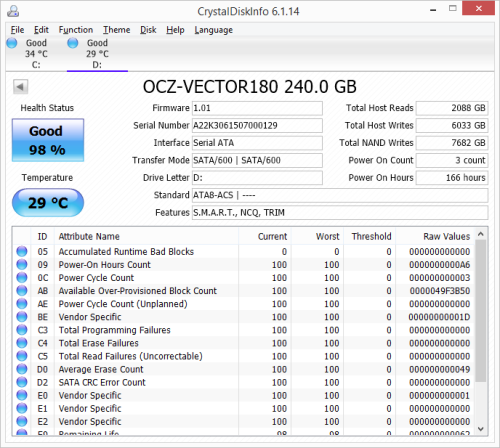
To test the Vector 180's TRIM and garbage collection functions, I first put the drive in a "dirty" state. I used Iometer to fill the entire drive and then ran a random write test for 30 minutes. Looking at the screenshot below, you can see that the Vector 180's average read and write speeds dropped to 251.0 MB/s and 111.3 MB/s, respectively.
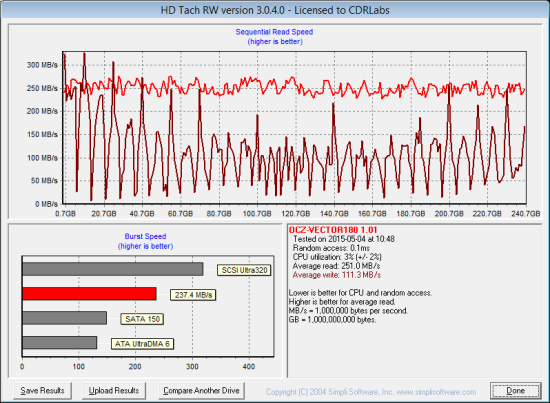
OCZ Vector 180 - Dirty
To see how well the Vector 180 could recover, I let the computer sit for about 45 minutes and then reran the test. The drive's average write speed jumped back up to 246.5 MB/s. However, its average read speed dropped down to 240.7 MB/s while it was recovering.
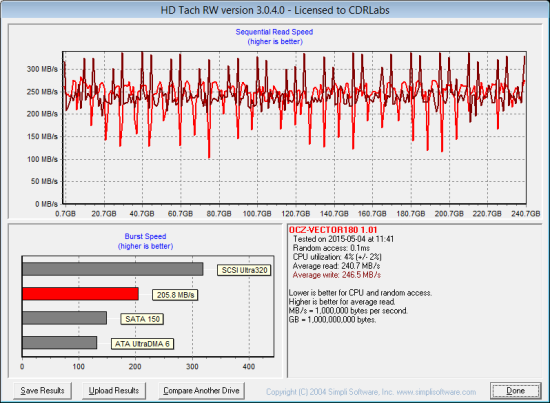
OCZ Vector 180 - After TRIM
Lastly, I used OCZ's Toolbox utility to perform a secure erase on the Vector 180. With the drive wiped clean, it had average read and write speeds of 369.4 MB/s and 292.6 MB/s, respectively.
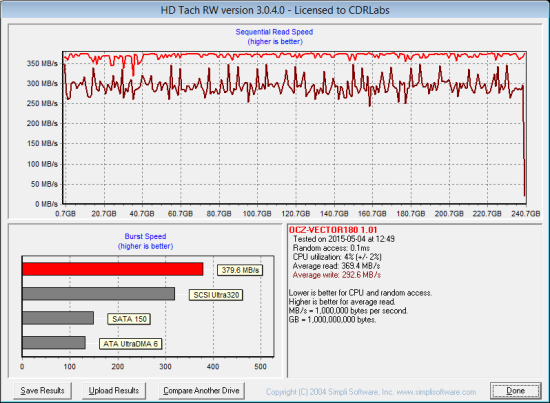
OCZ Vector 180 - Secure Erased
Final Thoughts:
Like OCZ's previous Vector series SSDs, the Vector 180 is a great choice for the gamer or enthusiast looking for a drive that provides exceptional performance, endurance, and reliability. Designed to power today’s high-end consumer systems, the Vector 180 combines the Indilinx-infused Barefoot 3 M00 controller with Toshiba's latest A19nm MLC NAND flash. As we've seen in the past, this combination is capable of producing some impressive performance numbers. In our sequential read and write tests, the 240GB Vector 180 was able to read at speeds as high as 557 MB/s and write at speeds in excess of 485 MB/s. It also did reasonably well in our random write tests, producing more than 53,000 IOPS at low queue depths. The Vector 180 performed better at higher queue depths. However, it still had a hard time keeping up with Samsung's 850 PRO.
Of course, impressive performance isn't the only thing the Vector 180 has to offer. The drive is equipped with an advanced suite of flash management tools which gives the it an industry-leading endurance rating of 50GB/day for 5-years. The Vector 180 also features OCZ's Power Failure Management Plus (PFM+) technology. Normally found on enterprise-class drives, PFM+ helps safeguard the SSD and its at-rest data in the event of unexpected system power loss. Sadly, the Vector 180 lacks support for Device Sleep (DEVSLP) mode as well as the TCG Opal and eDrive encryption standards. Given, this probably isn't an issue if you're looking for an SSD for your workstation or gaming rig. However, these are things you may want to consider if the Vector 180 is going in a laptop or data security is a concern.
The Vector 180 is available now in 120GB, 240GB, 480GB and 960GB capacities. Prices on Amazon and Pricegrabber currently range from $80 up to $460, with the 240GB version reviewed here going for about $135.

Highs:
- Available in 120GB, 240GB, 480GB and 960GB capacities
- Endurance rated at 50GB/day for 5 years
- Good sequential and random read and write performance
- Performs equally well with compressible and incompressible data
- SATA 6Gb/s interface
- Toggle Mode MLC NAND flash
- Large DRAM cache
- Supports TRIM and idle background garbage collection
- Well constructed design
- AES 256-bit encryption
- Power Failure Management Plus (PFM+) technology
- Includes a 2.5" to 3.5" adapter bracket
- Includes Acronis True Image cloning software
- 5 year ShieldPlus warranty
Lows:
- Random write performance at low queue depths could be better
- Does not support DEVSLP
- Does not support TCG Opal or eDrive encryption





